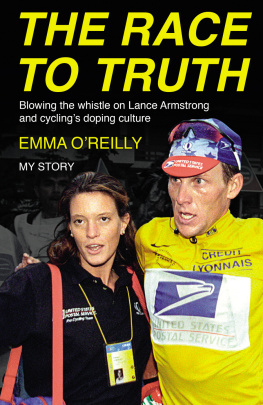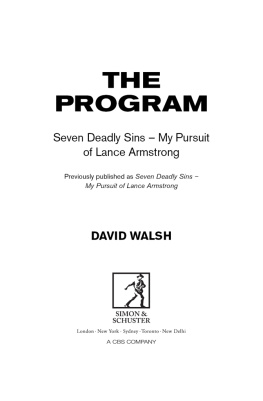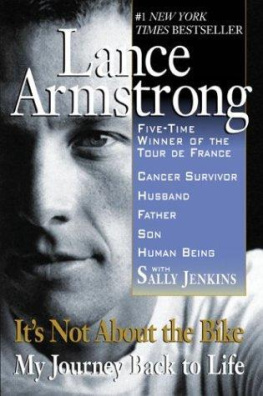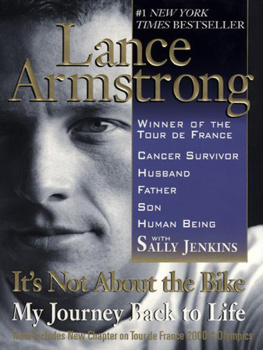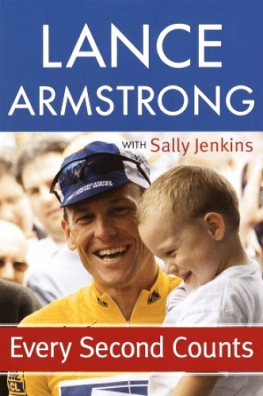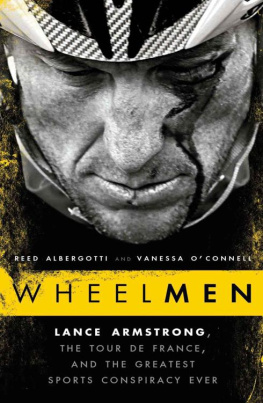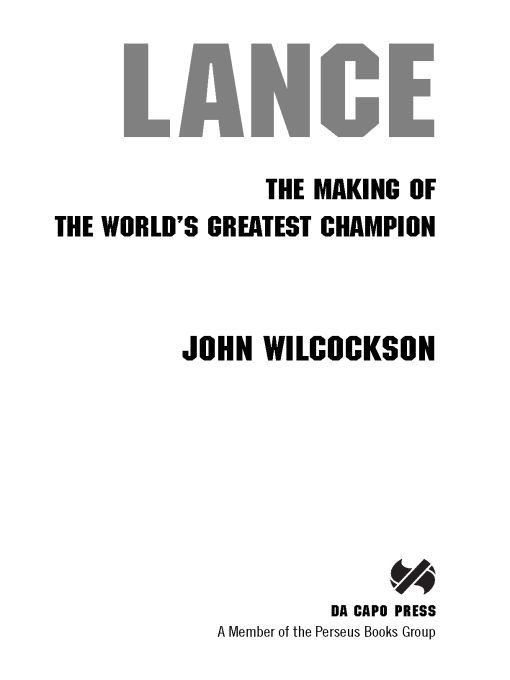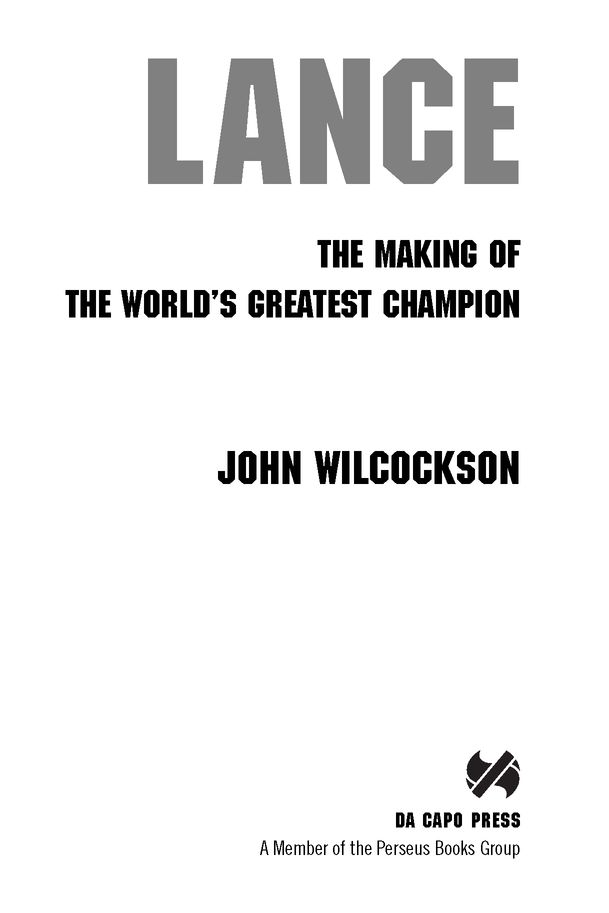Table of Contents
ALSO BY JOHN WILCOCKSON
23 Days in July: Inside the Tour de France
and Lance Armstrongs Record-Breaking Victory
John Wilcocksons World of Cycling
To Fabio, who died on his bike and lived with a smile
To Rene and Rita, for their spirit and inspiration
PREFACE
HEY, JOHN, IM ON TWITTER to tell people that were doing an interview. How many Tours have you covered?
Forty, I answer.
Thatll blow their minds, says the winner of seven of those Tours de France.
Hes now part of the races history, but Lance Armstrong always wants to learn more; I tell him a story about one of its legendary champions.
When I first saw the Tour, in 1963, my most vivid memory is being a spectator at the finish in Chamonix. It was the last day in the mountains, and Jacques Anquetil won the stage and took the yellow jersey. He walked right by me on his way to the podium. It was pouring rain, and when he was maybe five feet from me he took a comb from his back pocket and ran it through his wet, blond hair. He was like a movie star.
Anquetil was the first man to win the Tour de France five times. In the next three decades, three more Europeans equaled that record before an outspoken American who had raw talent, no respect for traditions, and no limits came along. Lance, like Anquetil, has a deep chest and long, lean legs and races a bike like the wind. But thats where the similarities end. Lance didnt even know that professional cycling existed when he grew up in suburban Plano, Texas.
Today, everyone knows the heroic story of a cyclist who survived a deadly cancer and went on to win the worlds toughest sporting event multiple times. Its a story that has inspired millions around the world and given rise to a cancer-awareness movement that is now becoming global. But few know how this once brash young Texan emerged from a modest childhood, grew up in a football culture, and worked his way to the top of a very un-American sporteven before he was diagnosed with cancer.
Lance, with immense fortitude, tackled cancer as he would later tackle the Tour: working with a team of friends, experts, and advisors to find the best solutions to the most challenging questions. That approach, combined with unparalleled dedication and discipline, enabled him to revolutionize a sport that has been dubbed the worlds most beautiful as well as its most brutal. Ultimately, by winning an unprecedented seven Tours in seven years, Lance laid claim to being the worlds greatest champion.
Who else can be considered for this supreme title? Thats a question Ive thought about since I was very young.
Growing up in an England recovering from wartime, when the populace found relief by watching sports, my brother and I became sports addicts. We constantly discussed who was the best this or the best that in every conceivable sport. We played street soccer and cricket, ran through the woods, climbed what we thought were mountains, and eventually rode our bikes to Europe and the Tour de France.
Our parents took us to London, where we saw many of the champions we talked about. We watched the England cricket team play the national teams from Australia, South Africa, and the West Indies. We saw and learned about that sports legendary Don Bradman, and we wondered how he compared with American baseball greats Babe Ruth and Ty Cobb. We went to watch our countrys mythic miler Roger Bannister and Australias tennis star Ken Rosewall. Before television, our crackling radio brought us live commentaries of the World Championship bouts of Joe Louis and Rocky Marciano, and Formula 1 motor races starring Argentinas Juan Manuel Fangio. We were ardent fans of our local soccer team and were awed by the skills of the immortal Pel.
Could any of these men claim the title worlds greatest champion?
Today, the most frequently touted candidates are the ballplayers. Michael Jordan electrified a nation with his competitive fire and sheer athleticism; Pel commanded a soccer field with unique on-the-ball skills, acceleration, and power to score goals that amazed; Tiger Woods can drive, chip, and putt a golf ball more spectacularly and consistently than anyone in history; Ruth dominated his era in baseball; and crickets Bradman, like Ruth, used his bat in the most punishing manner his sport has ever seen. Other contenders include Muhammad Ali, who transcended his sport with a combination of flashy showmanship, footwork, and counterpunching; runner Haile Gebrselassie, who, incredibly, set world records at every distance from five thousand meters to the marathon; and Formula One driver Michael Schumacher, who won a record seven world championships.
All of these athletes performed feats that dazzled the mind, but few conquered their sports leading event more than a handful of times and none faced an event as daunting as the Tour de Francewhich is so physically, mentally, and emotionally demanding it has even been called sadistic. In twenty-three days, the racers subject themselves to an Olympian test of endurance, completing twenty-one hundred miles of racing at blinding speed, battling fierce crosswinds across the plains, climbing like eagles over dozens of mountain passes, and racing downhill at the limit of human possibility. Their bodies must adapt to chilling rain and broiling heat, and one quarter of the starters succumb to crashes, injuries, and sickness before the finish.
Professional cycling is one of the few sports thats contested by teams and yet results in an individual winner. A pure athlete can win the Tour, but to keep on winning, year after year, demands a different kind of sporting perfection. Lance displayed all the expected gifts and competence of a champion athlete; used technology, physical therapy, and innovative training to the maximum; and acquired a layer of executive skills that enabled him to assemble, prepare, and command the strongest team the Tour had seen in a hundred years. Those accomplishments, along with the utter confidence he displayed to overcome whatever stood in his way, resulted in Lance being a greater, more assertive champion than any of the Tours five-time winners, going all the way back to cyclings first blond superstar, Jacques Anquetil, in the early sixties.
Lances story is interspersed with the people who influenced the course of his journey and allowed him to acquire the skills, the knowledge, and the assurance he has displayed throughout his athletic career and iconic life. Each of them, perhaps by design, entered his life when he needed them most and helped him grow, reach his potential, and finally become the worlds greatest champion.
PROLOGUE:JUST AN IDEA
AUGUST 12, 2008. It was two weeks after the Tour de France ended. I was eating lunch at my laptop when an e-mail message from Lance Armstrong popped up on the screen. The subject line was Chat. Curious, I clicked it open to read: John, You got a second to chat with bill and I? Thanks, L. Bill would be Bill Stapleton, his business partner and friend. I had no idea what they wanted to talk about and was intrigued. I hadnt heard from Lance since before the Tour. That was in late June, when in response to one of my questions about this book, he replied: Sorry for the delay. I am in santa barbara with my kids for the summer (escaping the heat!) and just relaxing....


